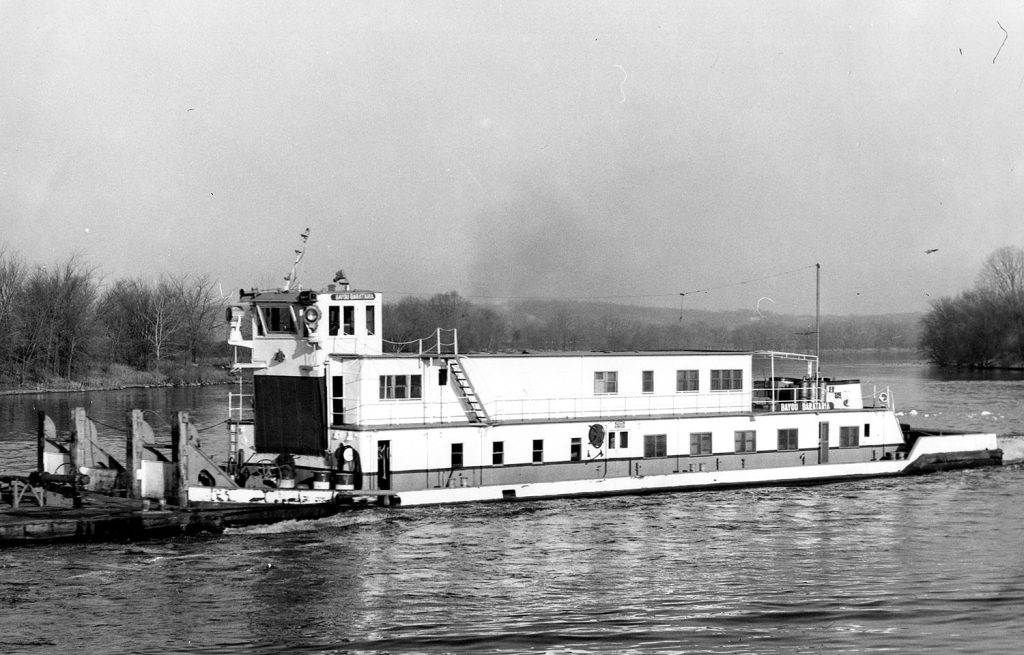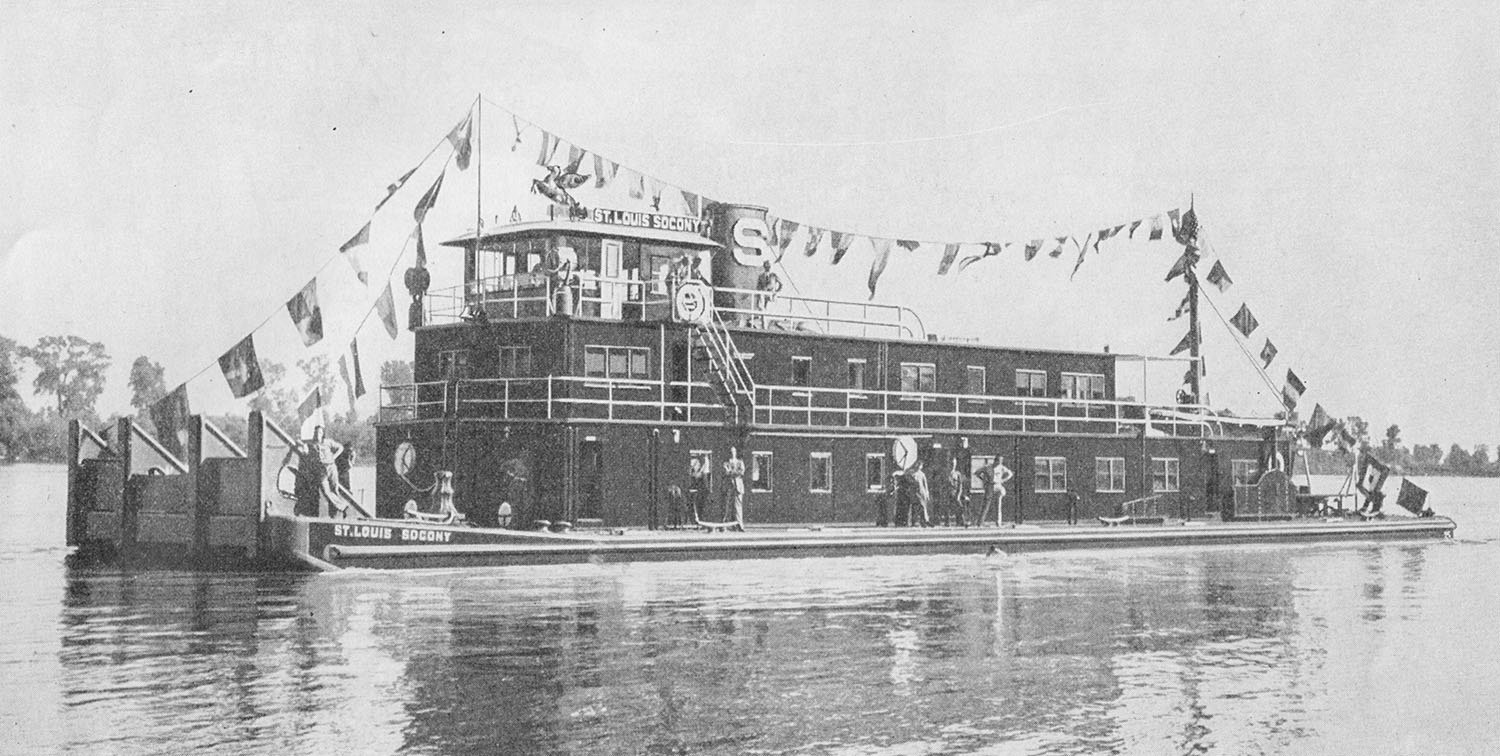In the Old Boat column that appeared in the September 18, 2023, issue of The Waterways Journal, the history of the first towboat built for the Socony Vacuum Oil Company, the Kansas City Socony, was detailed. It was 125 by 32 feet and had 1,020 hp. from a pair of Superior diesels.
The boat had been built at the Elliott-Fairfax Shipyard at Kansas City, as were four tank barges. The boat departed its namesake city on September 23, 1937, with two of the barges loaded with gasoline destined for St. Paul. After a rough first trip that took 28 days to complete, it finally arrived at St. Paul on October 19. Despite the difficulties of the initial trip, Socony judged it a success and announced plans to build five more towboats and 20 additional barges over the next three years.
The Kansas City Socony and the fleet of barges had been built under the supervision of Capt. Phil C. Elsey, originally with J&L Steel, Pittsburgh, and later the transportation manager of Raymond City Coal & Transportation Company. The St. Louis Items column authored by Andrew D. Franz in the January 15, 1938, issue of the WJ noted that Elsey had visited St. Louis the previous week, inspecting the plants of the Busch-Sulzer Bros. Diesel Engine Company and the St. Louis Shipbuilding & Steel Company.
In the same column of the March 16, 1938, WJ, it was said that with Capt. Louis Nyhammer as master, the Kansas City Socony was expected to “come out” in the Upper Mississippi towing trade after having been “laid up for some time at the St. Louis Shipbuilding and Steel Co.” due to ice conditions. It was anticipated that, by July 1, the company would have two towboats and 10 barges in its fleet, as a second boat and six barges were then under construction at St. Louis Ship.
In the September 24, 1938, WJ, the St. Louis Items column said that the Kansas City Socony had “passed up through the harbor Tuesday evening with six barges of gasoline for St. Paul.” Capt. Francis (Dusty) Rogers had been aboard as master with Capt. J.V. Rector as pilot. Capt. C.W. Brewer was also aboard, “posting up” preparatory to coming out as pilot on the “new boat,” which had been named St. Louis Socony. Capt. John W. Schmoker, assistant U.S. local steamboat hull inspector, and Alfred W. Metcalf, assistant U.S. local boiler inspector, had recently inspected the new St. Louis Socony.
The St. Louis Socony was of all-steel construction with a hull 138 by 35 feet. The twin-screw boat was powered by a pair of Busch-Sulzer six-cylinder diesel engines that were direct-drive, developing 1,200 hp. at 300 rpm. Evidently Capt. Phil Elsey’s January visit to the Busch-Sulzer factory had borne fruit. As with the earlier boat, this one had a long second cabin with a pilothouse situated forward above that and a single smokestack. The vessel was painted in the Socony dark red, and a large white “S” was on each side of the black stack.
The new boat had the same boxy, squarish build of the Kansas City Socony, and if anything was even more so. The Kansas City Socony at least had rounded edges to the tops of the cabin, but this new boat was severely square with no hint of shear or camber. The J.H. Duffy, which St. Louis Ship had turned out just prior to this one, had been touted for “streamlined” design, but this new Socony boat must have had a distinctly different designer.
Socony added an additional boat in 1940, the 1,500 hp. St. Paul Socony (WJ February 5, 2024) built by Ingalls at Decatur, Ala. In 1951, the company had the 3,200 hp. La Crosse Socony built at St. Louis Ship and sold the Kansas City Socony. In the spring of 1952, the St. Louis Socony was also sold to new owners. The boat was purchased by Oil Transport Company, New Orleans. The name was changed to Bayou Barataria, and initially little else was changed other than the paint scheme, with the deep red giving way to the green color that the “Bayou Fleet,” as Oil Transport was known, being placed on the lower and upper cabins. The pilothouse and stack were white with dark green accents, and the tree-shaped logo of the Bayou Fleet was on each side of the stack.

At some point prior to 1955, the boat was rebuilt with a retractable pilothouse. Rather than removing the second cabin, it was retained with a pilothouse that lowered into the forward part of the cabin. The single stack was gone, and short exhaust pipes extended through the roof. Some photos show three short stacks that were apparently removable, as they are seen sitting aft of the upper cabin at times. In 1956, the original direct-reversing Busch-Sulzer engines were replaced by a pair of GM 12-567 diesels with a total of 1,800 hp.
As with many of the older boats, there is some confusion regarding ownership. The Inland River Record indicates that the boat was sold in 1956 to United Marine, New Orleans and continued to be operated by Oil Transport under charter. In later years it is shown as having been sold to American Marine Corporation, New Orleans. The List of Merchant Vessels shows it owned by American Marine after 1957. A photo taken by the late Dan Owen in 1965 shows it painted white, with old English letters “UMC” on the portable stacks.
The boat was last listed in the 1979 edition of the IRR, and it appeared in the Off The Record section of the 1980 book, with the notation that it was “out of service.”
Caption for top photo: Shipyard glamour shot from a Busch-Sulzer ad in the WJ of December 31, 1938. (David Smith collection)




